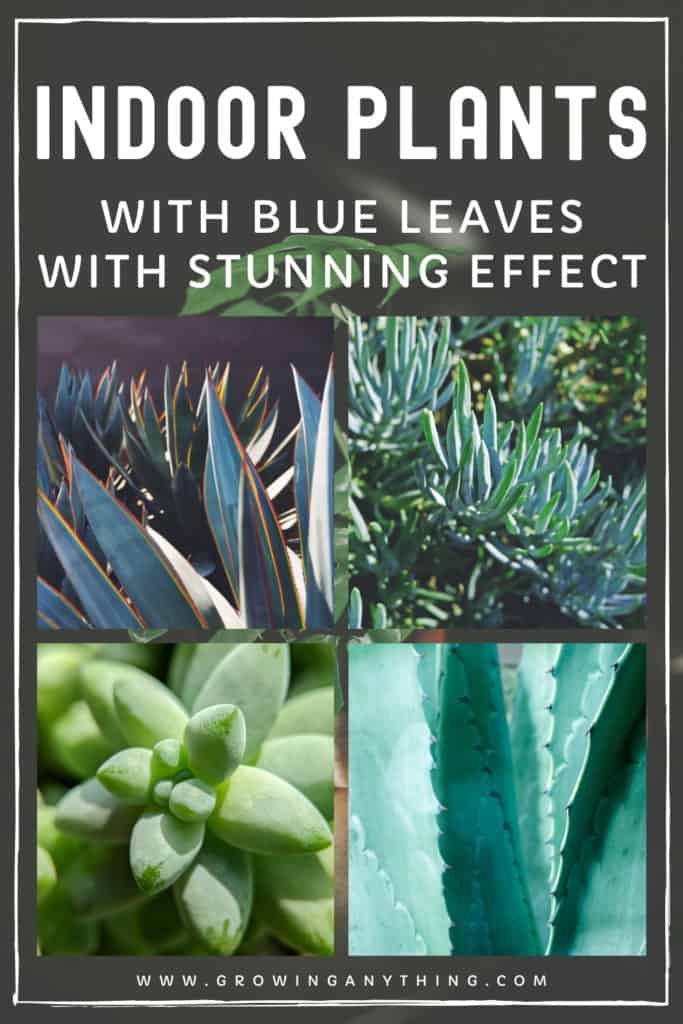22 Indoor Plants With Blue Leaves
Are you interested in indoor plants with blue leaves? Me too! I compiled a comprehensive list of houseplants with blue foliage! They will enrich every plant collection and blend in every indoor space!
Most houseplants feature green foliage, and everything beyond that, including silverish and bluish hue on the leaves, instantly transform every space!
The plants from the list have diverse growing requirements. Some may need a lot of sunlight to maintain glossy blue leaves, and others need partial shade to prevent scorching and burns.
Don’t get confused, here is all you need to know about plants with blue foliage!
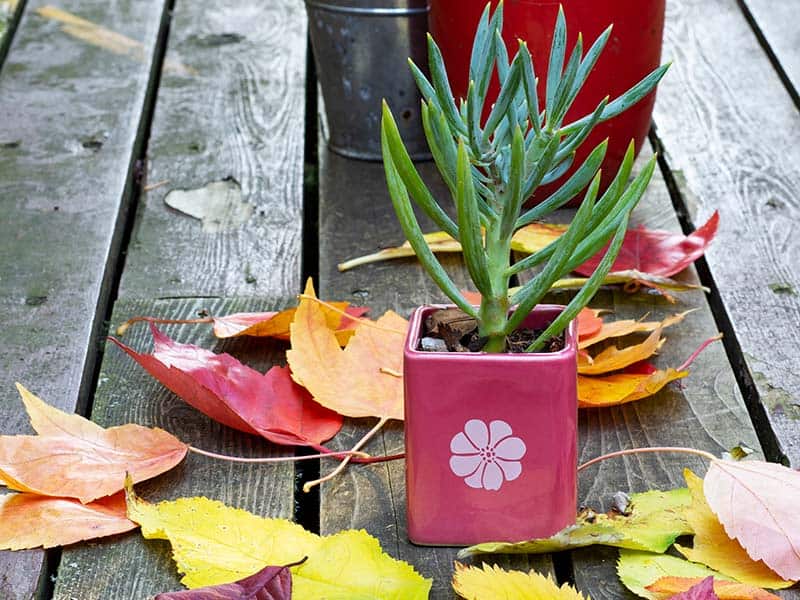
1. Blue Glow Agave
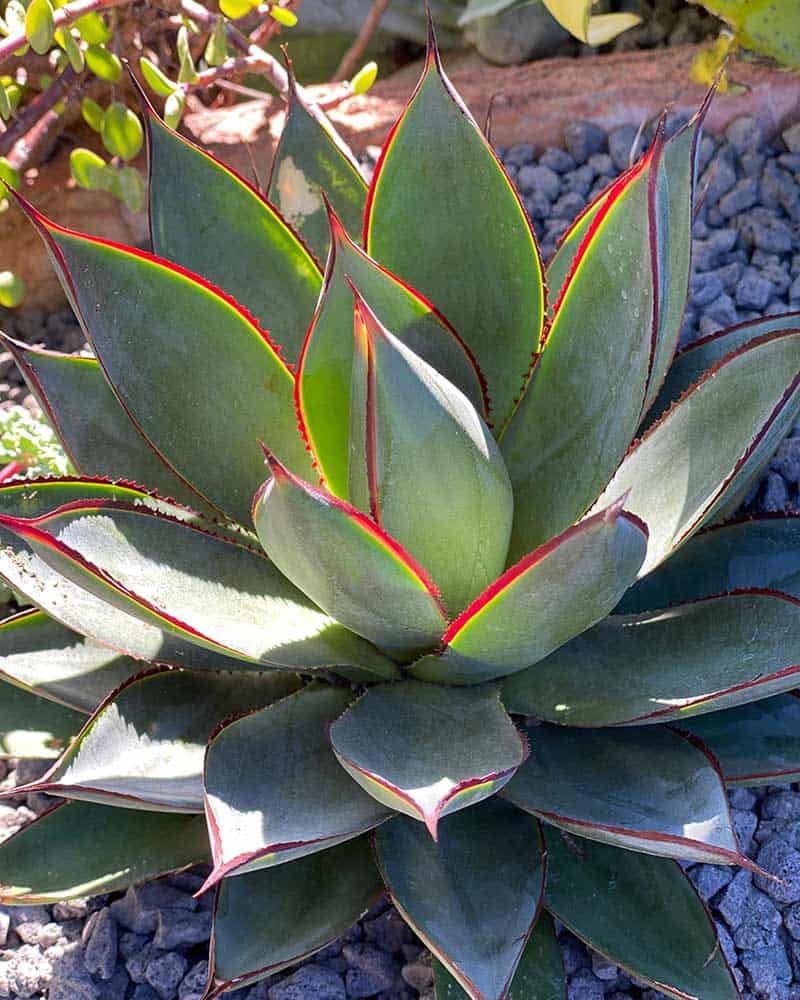
Blue glow Agave is a beautiful succulent and a cross between two plants – Agave attenuata and Agave ocahui. It is one of the most compact varieties of Agave, and it doesn’t get taller than 24 inches.
Blue glow Agave only blooms once per lifetime. Once the plant graces you with a beautiful flower, it will dry and die. If you want to prevent blooming, don’t fertilize the plant.
Like many other succulents, Blue Glow Agave is drought tolerant. It thrives in partial shade or full sun and needs minimal care to grow.
Troubleshooting your Agave plant – Most common problems.
2. Burro’s Tail
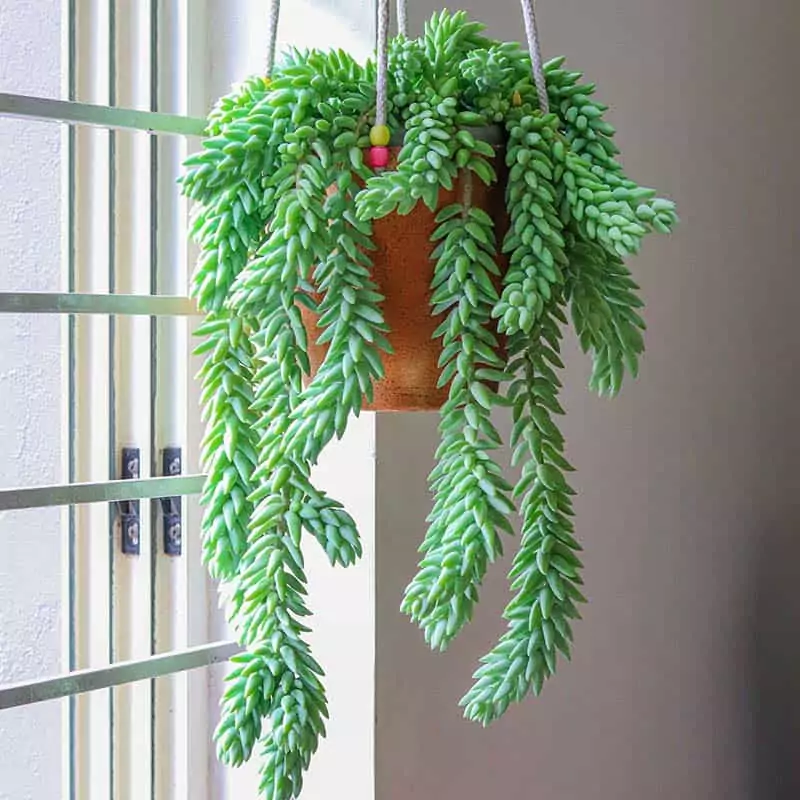
Burro’s Tail or Sedum morganianum features attractive blue-green foliage and a slight chalky effect. The succulent needs excellent drainage, optimal sunlight, and medium watering to thrive.
Burro’s Tail is cold-sensitive so it needs protection against frost. As a houseplant, Burro’s Tail is a low-maintenance, attractive plant that looks best when placed in hanging baskets!
But, Burro’s Tail isn’t an easily adaptable plant. When you wish to change the condition or location, allow the plant to acclimate to new conditions first.
3. Blue Agave
Agave tequilana comes from Mexico and is known as the Blue Agave plant. It is a large and striking plant with stunning silver-blue leaves. You can grow it outdoors only in warmer zones, nine and ten. Outside these zones, you can grow Blue Agave in containers indoors.
Blue Agave needs well-draining soil and six hours of sunlight. After planting, Blue Agave needs frequent watering. If the temperatures are hot, you can water the plant once a week. As it grows, Blue Agave develops tolerance to drought.
The average lifespan of Blue Agave is between eight and 14 years. In that time, it only blooms once.
4. Creeping Blue Sedum
The ideal time to plant Sedum sieboldii or Creeping Blue Sedum is early spring. It thrives in average rich and fertile soil and needs excellent drainage. Creeping Blue Sedum may tolerate partial shade, but it shows its true colors and beauty in full sun.
Established plants are low-maintenance. You can check if the soil is dry before watering for the best results. During winter, Sedum needs minimal moisture.
5. Blue Barrel Cactus
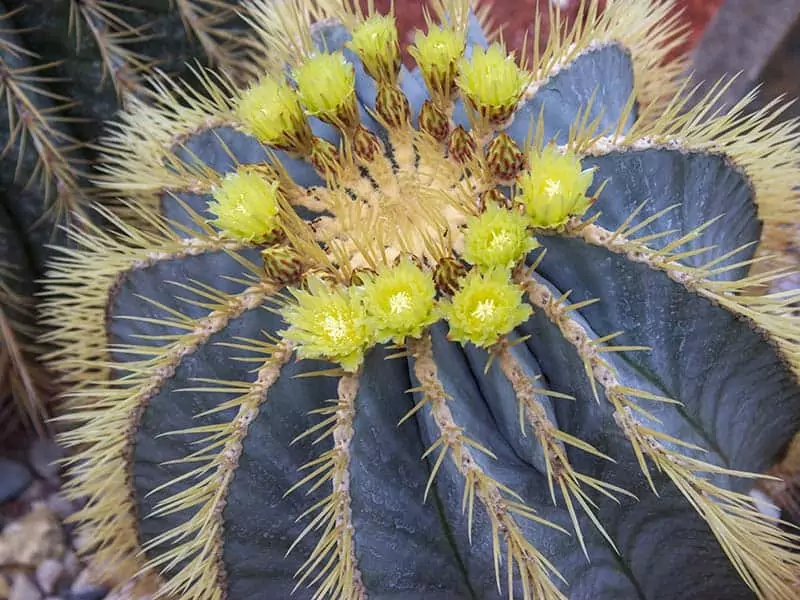
Blue Barrel Cactus features a round shape, attractive flowers, and foliage. The plant’s scientific name is Ferocactus glaucescens, and it comes from Mexico.
Blue Barrel Cactus is a slow-grower, and it requires patience to grow. Luckily, you don’t need to be a pro in gardening to grow this unusual bluish succulent! It will do great even without your assistance!
You only need to water it during extremely hot temperatures. Fertilizer is optional, and as long as Blue Barrel gets sunlight, it will grow according to its pace!
Repoting Blue Barrel Cactus: Foolproof guide.
6. Hybrid Century Plant
Agave ovatispina, cultivar Blue Rapture is better known under the name Hybrid Century plant. It is another Agave variety with bluish foliage and an attractive appearance. Blue Rapture has green leaves with blue edges, which give the plant a unique appearance.
Hybrid Century Plant needs a lot of time to flower. Overall, the cultivar doesn’t need any special care. Anything that worked for previous Agave plants, will work for the Blue Rapture.
Unfortunately, Blue Rapture may be quite difficult to find in local nurseries.
7. Blue Cereus
Browningia Hertlingiana or Blue Cereus is a beautiful cactus, often grown as an outdoor plant in dry tropical climates. However, you can also pick Blue Cereus to expand your houseplant collection!
Blue Cereus is easy to recognize by its elongated blue-green body. The cacti like full sun but can tolerate partial shade during hot summer days. If you keep the plant on a sunny window, don’t forget to rotate the pot so the entire plant can get even sunlight exposure.
Overall, Blue Cereus cacti are suitable for beginners. Allow the soil to dry between waterings, and your Blue Cereus will thrive. If the plant grows too large, you can keep it outside during warmer parts of the year.
Is Blue Cereus easy to propagate?
8. Blue Myrtle Cactus
Myrtillocactus geometrizans or Blue Myrtle Cactus is a large plant when you grow it outdoors. Blue Myrtle Cactus is native to Mexico and Guatemala.
Indoors, it remains compact and doesn’t need complex care. Interestingly, the Cactus blooms in the summer and produces edible blue berries. Therefore, people sometimes call it Blueberry cactus, and the berries are a common snack in Mexico.
Blue Myrtle Cactus need bright sunlight, indoors and outdoors. When the winter comes, place Blue Myrtle Cactus somewhere chilled so it can rest and wait for the spring growing season.
9. Blue Bird
Crassula ovata Blue Bird is a hybrid plant with beautiful blue-green foliage with red edges. Blue Bird blooms in the spring and looks especially beautiful in ornamental containers.
It is a succulent which loves full sun and is highly sensitive to overwatering. Therefore, plant it in the pot with drainage holes and use airy, well-draining soil. Blue Bird is also sensitive to cold temperatures. So, you can grow it indoors year-round or keep it outside only during the warmest parts of the year.
You can propagate Blue Bird via cuttings or seeds.
Guide for growing Blue Bird from cuttings.
10. Sea Stars
Sedum pallidum Sea Stars or Stonecrop is hardy in zones five to eight. You can easily grow Sea Stars from cuttings or start it by division. The plant needs average soil and medium moisture. It can also tolerate dryness and heat once it is established.
Sea Stars is a beautiful plant with tiny blue-gray leaves. It grows in dense mats and can be grown in containers indoors or outdoors as a ground cover. During fall, the foliage turns brown.
Sea Stars also look attractive in the blooming season in late summer, with small charming white flowers.
11. Cebu Blue Pothos
Cebu Blue Pothos is an easy plant to start from cuttings. The plant features glossy silver-blue foliage and grows as a perennial vine.
The scientific name is Epipremnum pinnatum. It is native to northern Australia, some parts of Asia, and Europe. In its native habitat, Cebu Blue Pothos flowers. But, it is highly unlikely to happen in households.
When you grow Cebu Blue Pothos as a houseplant it can reach about four feet. You’ll also have to prune the plant to stay tidy.
12. Cream Spike Agave
Cream Spike Agave is a striking plant with pointy, blue-green foliage forming a rosette. In addition, each leaf has yellow margins and thorns, which give the plant a unique look.
Cream Spike Agave remains tiny and is easy to grow. It doesn’t suffer from diseases and pests. But, if you keep it outside, monitor the plant for snails.
The lovely succulent grows up to ten inches and looks lovely in small containers on a sunny window.
13. Short Leaf Aloe
Aloe brevifolia aka Short Leaf Aloe needs at least six hours of sunlight per day to thrive. Still, the plant can adapt to partial shade, but it won’t look as beautiful as possible.
Short Leaf Aloe prefers warm temperatures between 70 and 80 degrees Fahrenheit. It is somewhat drought-tolerant and relatively low-maintenance succulent.
The soil should never be soggy because it can kill Short Leaf Aloe. The first symptoms of overwatering are short and mushy leaves.
Fertilization is optional, but the plant may benefit from occasional feeding.
14. Blue Whale
Blue Whale Peperomia is one of the most stunning houseplants with blue and textured leaves! It is a tropical plant that loves full sun but may tolerate light shade.
Because of the evergreen foliage, Peperomia Blue Whale remains attractive year-round. It has medium watering needs and a relatively easy-going nature.
15. Silver Sword Philodendron
You can start growing Silver Sword Philodendron from stem cuttings. Keep the cutting in water for several weeks and transplant when the roots appear. Use a well-draining potting mix and watch your plant thrive!
Silver Sword Philodendron is relatively pests resistant, but it can suffer from mealybugs and aphids.
An optimal watering schedule will help maintain the plant’s health. Allow the top two inches of soil to dry before watering it!
16. Blue Metal
Echeveria Blue Metal, shortly Blue Metal is a low-growing succulent. Even though Blue Metal is drought-tolerant, regular irrigation helps the plant develop spectacular bluish foliage.
You can start Blue Metal any time of the year via seeds or cuttings. The plant will benefit from partial shade and winter protection.
Interestingly, Echeveria Blue Metal might flower a few times in a year!
Inspiration for arranging Echeveria in succulent arrangements.
17. Blue Oil Fern
Blue Oil Fern aka Microsorum thailandicum grows best when you keep the container in a west or east-facing window. It has medium sunlight requirements, which means the plant will grow under morning sunlight and afternoon shade.
With Blue Oil Fern, you don’t have to worry too much about water. The plant is somewhat drought-tolerant and forgiving. Ideally, the top two inches of the soil should be dry before you water Blue Oil Fern.
Blue Oil Fern also needs fertilization to survive. Nitrogen, phosphorus, and potassium fertilizer should be sufficient to keep your Oil Fern healthy. Water-soluble products will be the best for Blue Oil Fern.
18. The Dark Lord
The Dark Lord or Philodendron Rugosum is a large-leaf houseplant. Juvenile Dark Lords have orange leaves. As the plant matures, the foliage turns red, which fades into a green with a bluish and metallic sheen.
The Dark Lord may seem intimidating because of the large and striking leaves, but it is one of the easiest plants to grow. It is a vigorous grower, so maintaining a compact size can be a challenge!
Dark Lord is a hybrid, and it needs a rich, organic mix to grow to its full potential. Keep the pot in partial shade and the soil evenly moist, and your Dark Lord will grow happily and healthily!
Fertilize Dark Lord cautiously, because too much fertilizer can cause root burns.
19. Eucalyptus Baby Blue
Eucalyptus Baby Blue can be grown indoors, and it grows fast! The easiest way to start it is to get a tiny plant from the local nursery. Don’t disturb the roots and choose airy, well-draining soil during transplantation.
The trick you can use is to cut the plastic container the plant came in and gently move the Eucalyptus into a bigger pot without touching the roots.
Baby Blue Eucalyptus needs a lot of sunlight. The ideal indoor location is a south-facing window. Keep the plant outdoors in the summer and bring it in as soon as the temperatures drop.
20. Big Blue Chalk Sticks
Big Blue Chalk Sticks or Senecio Blue Chalk needs fast-draining soil mix to thrive. You can also grow it in sandy soil and avoid chalk soil to keep Senecio healthy.
Big Blue Chalk Sticks don’t mind limited watering. If you want to boost the growth, fertilize the plant with low-nitrogen plant food or use weak compost.
After summer, cut the plant back if you want more Blue Chalk Sticks!
21. Hosta
Hostas are often used outdoors. But, if you take good care of them, Hostas can grow indoors. Hostas don’t mind shade and thrive where other plants can’t survive.
The trick for growing Hostas as houseplants is to ensure they get a dormant period every year in a chilled room. It will allow them to survive indoor conditions.
However, don’t forget to keep Hostas away from pets because they are toxic to cats and dogs.
22. Chinese Dunce Cap
The last on my list of beautiful indoor plants with blue foliage is the Chinese Dunce Cap aka Orostachys Iwarenge. It is a cute little succulent with low-maintenance nature and an attractive appearance. Chinese Dunce Cap only blooms once per lifetime, but most people grow it because of the attractive foliage.
The succulent is native to Japan and can be kept outdoors in USDA hardiness zones from five to ten. You can also grow it indoors outside these zones.
Chinese Dunce Cap prefers full sun, excellent drainage, and slightly cooler night temperatures.
Blue Is The New Green
Houseplants with blue leaves can spruce up every plant collection! As you can see, you’ve got a lovely choice in front of you!
From tiny succulents and cacti to flowering plants and large-leaf varieties, blue-leaved plants are spectacular!
I got my eyes on Big Blue Chalk Sticks, but I wouldn’t mind getting me some Hostas indoors! Which blue-leaved plants will you choose for your home?
If you enjoyed the article, show some love and share it with your friends and family!
